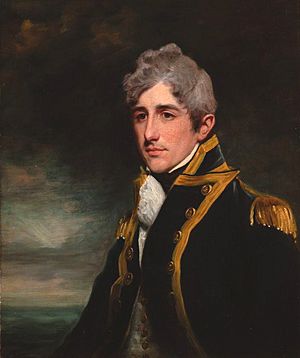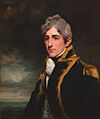John Spratt Rainier facts for kids
Quick facts for kids
John Spratt Rainier
|
|
|---|---|

Rainier in captain's uniform, ca 1796
|
|
| Member of Parliament for Sandwich | |
| In office April 1808 – September 1812 |
|
| Personal details | |
| Born | 1777 Sandwich, Kent |
| Died | 13 November 1822 (aged 44) Portsmouth, Hampshire |
| Resting place | St Mary's Church, Sandwich |
| Spouse |
Elizabeth Deare (1780–1872)
(m. 1806) |
| Relations | Admiral Peter Rainier (uncle) Captain Peter Rainier (cousin) |
| Military service | |
| Allegiance | |
| Branch/service | |
| Rank | Rear-Admiral of the Blue |
| Commands |
|
| Battles/wars | French Revolutionary Wars:
|

John Spratt Rainier (born in 1777, died November 13, 1822) was an important officer in the Royal Navy. He rose to become a high-ranking officer called a Rear-Admiral. He also served as a Member of Parliament for Sandwich from 1808 to 1812.
Contents
Early Life and Family Connections
John Spratt Rainier was born in Sandwich, Kent, in 1777. He was the second son of Daniel Rainier, who was a wine merchant and had been the mayor of Sandwich. His mother was Margaret Heath. John's family had Huguenot origins, meaning they were French Protestants who had moved to England.
The Rainier family had strong ties to the navy. Many of John's relatives had impressive careers in the Royal Navy. His uncle, Admiral Peter Rainier, was a famous naval officer. Later, John's cousin, also named Peter Rainier, became a Captain in the navy.
John Rainier joined the Royal Navy as a young man. He started as a midshipman, learning how to be a naval officer.
Rising Through the Ranks
In May 1794, John was promoted to lieutenant. In 1795, he was assigned to the ship HMS Suffolk. This ship was the main ship for the East Indies Station, where his uncle, Peter Rainier, was in charge. His uncle helped him get promoted quickly.
By February 1796, John Rainier became a commander. He took charge of a ship called HMS Swift, which had 16 guns. With this ship, he helped capture the islands of Ambon and Banda Neira in the Dutch East Indies. There wasn't much fighting during these captures.
In December 1796, when he was only 19 years old, John was promoted again to post-captain. He first commanded HMS Vindictive and then HMS Dordrecht.
Commanding HMS Centurion
In April 1797, Rainier took command of HMS Centurion. This was a powerful ship with 50 guns. He stayed in the East Indies for a while. From 1799 to 1800, his ship was based in the Red Sea. This was because the British thought the French, led by Napoleon, might try to build warships there.
In August 1800, HMS Centurion returned to Batavia. There, Rainier and his fleet captured five Dutch armed ships and destroyed 22 others. When naval crews captured enemy ships and their goods, they received "prize money". This was a reward for their success. John Rainier received prize money several times, including in October 1801 when the Centurion captured two ships, the Anna Margaretta and the Holstein.
In September 1804, Rainier was sick on land when the Centurion fought in the Battle of Vizagapatam off the coast of India. In November of that year, his ship returned home for repairs and was taken out of service.
John Rainier's last command was the 74-gun ship HMS Norge in 1810–11. He spent much of his later service on "half-pay", meaning he was still in the navy but not actively serving on a ship. In August 1819, he was promoted to Rear-Admiral of the Blue.
The National Maritime Museum in London has some of John Rainier's personal items. These include his Admiral's cocked hat and his log books. These log books show what happened on HMS Swift between October 1796 and February 1797.
Serving in Parliament
In 1807, John's uncle, Admiral Peter Rainier, became a Member of Parliament for Sandwich. When his uncle passed away in 1808, there was a special election to choose a new Member of Parliament.
Becoming an MP
John Rainier was chosen to take his uncle's place in April 1808. He had the support of the government at the time. After the election, another candidate tried to say that Rainier's election wasn't fair, but it didn't work.
Even though he was still a naval officer, John Rainier wanted to spend time in Parliament. In January 1809, he asked the Admiralty for leave from his ship so he could attend the House of Commons.
Rainier never made a formal speech in Parliament. However, records show he often attended meetings and voted. He usually supported the government, but sometimes he voted with the opposition. He decided not to run for re-election in 1812.
Personal Life and Achievements
John Rainier married Elizabeth Deare on March 12, 1806. They had one child, a daughter named Eliza Spratt Rainier, who was born in 1809.
A Wealthy Man
In 1808, John inherited a lot of money from his uncle, Admiral Rainier. His uncle had become very rich during his naval service, mostly from prize money. This inheritance, combined with the prize money John had earned himself, made him a very wealthy man for his time.
In January 1818, John Rainier was chosen as a fellow of the Royal Society. This was a great honor, as he was known for his knowledge in many areas of science.
John Rainier passed away in Portsmouth on November 13, 1822, at the age of 44. He was buried in Sandwich. There are memorials for both John Spratt Rainier and his uncle, Admiral Peter Rainier, in St Mary's Church, Sandwich.
Images for kids
-
Rainier's memorial in St Mary's Church, Sandwich, Kent



